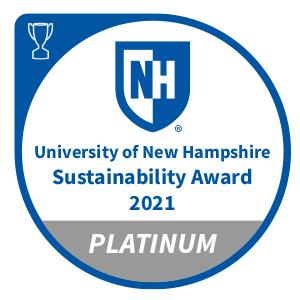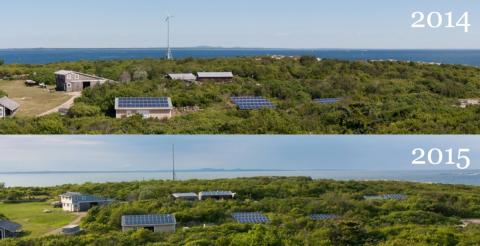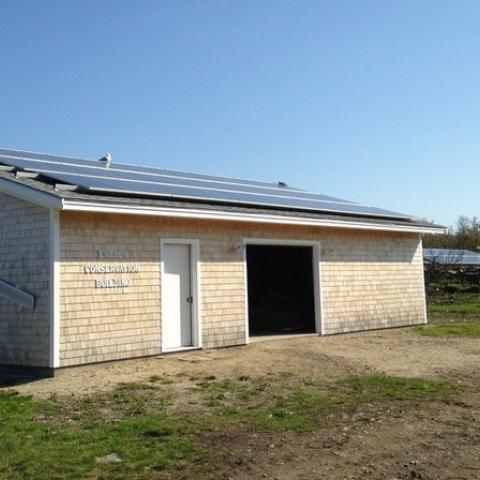Sustainability and environmental stewardship are core values of the Shoals Marine Laboratory! We are committed to advancing our sustainable infrastructure, as well as providing educational programs that focus on sustainability.
Over the last 50 years, the entire SML community has participated in these efforts and helped us achieve: an innovative green power grid (utilizing solar and wind energy), water conservation programs, a composting center, and more! Shoals is Sustainable.
What makes SML sustainable?
- Solar-powered energy (as of summer 2024, SML has 115.2 kW from PV panels.)
- Wind-powered energy (10 kW from wind turbine)
- Composting toilets (reduce wastewater and freshwater consumption)
- Food composting
- Rainwater collection systems for garden watering and toilet flushing (in Bartels)
- Single-stream recycling program
- Energy efficient appliances and LED lights
Our sustainability efforts produce real savings to our island operations, allowing us to reinvest in our educational mission!
SML's power grid has a sustainability dashboard to document power usage during the season. This live feed includes information on solar, wind, generators, and more.

Here's How We Did It!
Until the mid-2000s, Shoals Marine Laboratory was powered exclusively by diesel generators. If the generators went down, the lights went out. By 2006, SML was consuming on average over 10,000 gallons of diesel per year. Since then, through the implementation of green energy solutions and our dedication to energy savings, SML has cut diesel fuel consumption by 80%. In 2019, we used just over 1,100 gallons of diesel on Appledore!
UPDATE: In the summer of 2024, SML only used around 150 gallons of diesel. This is a 98.5% reduction in diesel fuel from the 10,000 gallons/average we used to use!
Here's the timeline of our recent energy saving and conservation initiatives:
2006: Sustainable Engineering Internship program begins.
2007: First solar panels (4.5 kW) are installed on Dorm 3.
2007: 80-ft Bergey wind turbine is erected.
2009: 3.0 kW of solar panels installed on the roof of Dorm 2.
2011: Water Conservation Building opens. Composting toilets and solar hot water heating system installed.
2013: Energy Conservation Building ("ECB") constructed to house solar and wind-powered battery bank. (NSF Grant DBI FSML 1226859)
2014: 26 kW of solar panels installed around the ECB. "Green Grid" hub (batteries, inverters, etc.) connected inside the ECB.
2015: 29 kW of solar panels added thanks to the "Bringing Energy Conservation to Light!" Crowdfunding campaign.
2016: 17.6 kW of solar panels installed. Ground-mounted arrays that are fed into the ECB.
2018: New green grid installed due to a donation from Sean O’Day (Cornell alum). 29.4kW of solar panels installed on the roof and 80kWh of battery storage in order to power the salt water pump that runs 24/7 all season.
2019: Replaced decades-old Kiggins Commons walk-in cooler and freezer refrigeration with more energy-efficient equipment.
2021: Replaced 7.5kW Bergey wind turbine built in 2007 with 10kW turbine in 2021.
2023:
- Removed the solar panels from the roofs of Dorms 2 and 3. Recycled the AGM lead acid batteries that had been installed in 2007.
- Replaced the lithionics batteries in Kingsbury House (K-House) with the AGM lead batteries from the Energy Conservation Building (ECB). This system powers SML's salt water pump and provides power for critical equipment during the winter months.
- Energy Conservation Building (ECB): Upgraded to new lithium phosphate batteries with about 355 kWh of battery storage (about 320 kWh usable).
2024: 30.24 kW of new PV solar panels installed. Ground-mounted arrays that are fed into the ECB.
Outreach & Education
See Sustainable Appledore first-hand! Shoals Marine Laboratory welcomes all SML courses and visitors to learn about island sustainability initiatives. Just to name a few:
-
Tours of our Energy Conservation Building and Water Conservation Building for all SML students and public visitors
-
Sustainable Engineering Internship, for undergraduates
-
Sustainable Fisheries, undergraduate course
Tech Specs: "The Green Grid"
The Shoals Marine Laboratory maintains two diesel generators and two green energy grids to provide 24 hr/day electrical power. The green energy grids collect power from the sun and wind through photovoltaic (PV) panels and the wind turbine, which is then stored in AGM and lithium phosphate batteries. The main battery bank is housed in the Energy Conservation Building (2014).
The two green energy grids feed into battery banks creating a storage capacity of approximately 443 (345 usable) kilowatt hours at a nominal 48 Volt DC. This stored power is inverted to AC electricity for distribution to the island’s 14 buildings.
When there is not enough wind and sun to meet the island’s electrical demands, diesel generators are used to provide the necessary backup power.




